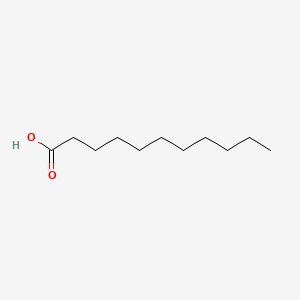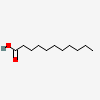Undecanoic Acid
- UNDECANOIC ACID
- 112-37-8
- Hendecanoic acid
- Undecylic acid
- undecanoate
- Create:2004-09-16
- Modify:2024-12-27

- UNDECANOIC ACID
- 112-37-8
- Hendecanoic acid
- Undecylic acid
- undecanoate
- n-Undecanoic acid
- n-Undecoic acid
- n-Undecylic acid
- Undecoic acid
- 1-Decanecarboxylic acid
- FEMA No. 3245
- Undekansaeure
- NSC-7885
- Undecanoate [USAN]
- CHEBI:32368
- 138ON3IIQG
- MFCD00002730
- DTXSID8021690
- Undecanoate;Hendecanoic acid
- CH3-[CH2]9-COOH
- UNDECANOIC ACID [FHFI]
- DTXCID001690
- C11:0
- NSC7885
- 64118-43-0
- FA 11:0
- undecanoicacid
- 1-decanecarboxylate
- CH3-(CH2)9-COOH
- NSC 7885
- EINECS 203-964-2
- UNII-138ON3IIQG
- BRN 1759287
- nUndecylic acid
- nUndecoic acid
- AI3-02280
- nUndecanoic acid
- 1N-Undecoic acid
- undecansäure
- 1Decanecarboxylic acid
- Undecanoic acid, 98%
- 63400-07-7
- bmse000563
- Undecanoic acid (Standard)
- SCHEMBL9266
- NCIOpen2_009435
- 4-02-00-01068 (Beilstein Handbook Reference)
- WLN: QV10
- UNDECANOIC ACID [INCI]
- CHEMBL108030
- GTPL5533
- QSPL 035
- QSPL 155
- QSPL 192
- Undecanoic acid, >=97%, FG
- HMS3740G13
- HY-W004282R
- Tox21_201031
- Undecanoic acid, analytical standard
- BDBM50511006
- LMFA01010011
- AKOS000276906
- CS-W004282
- DS-6048
- HY-W004282
- PB44018
- NCGC00248901-01
- NCGC00258584-01
- BP-27912
- CAS-112-37-8
- FA(11:0)
- SY007756
- DB-222294
- NS00014192
- S9454
- U0004
- EN300-19485
- C17715
- P19940
- Q425988
- J-002761
- 75EF58E9-1C6B-4875-8B82-D0B7A10FAEA2
- F2191-0248
- Z104473988
60.0 99.99
73.0 90.02
41.0 76.89
43.0 69.96
55.0 48.08
117.0 1
129.0 0.40
243.0 0.40
132.0 0.31
131.0 0.22
185.1552 100
186.1581 8.51
185.1545 100
186.1582 7.51
167.143 2.50
185.1552 999
186.1581 85
187.1605 6
185.5854 5
185.1545 999
186.1582 75
167.143 25
60 999
73 900
41 769
43 700
55 481
213.1871 100
214.1901 13.91
449.3617 5.51
313.1112 4.60
281.1739 2.90
- Extracellular
- Membrane
- Agricultural chemicals (non-pesticidal)
- Lubricants and lubricant additives
2019: <1,000,000 lb
2018: <1,000,000 lb
2017: <1,000,000 lb
2016: <1,000,000 lb
- Food, beverage, and tobacco product manufacturing
- All Other Basic Organic Chemical Manufacturing
- Pesticide, Fertilizer, and Other Agricultural Chemical Manufacturing


H314 (20.9%): Causes severe skin burns and eye damage [Danger Skin corrosion/irritation]
H315 (78.2%): Causes skin irritation [Warning Skin corrosion/irritation]
H318 (20.9%): Causes serious eye damage [Danger Serious eye damage/eye irritation]
H319 (66.8%): Causes serious eye irritation [Warning Serious eye damage/eye irritation]
H335 (65.4%): May cause respiratory irritation [Warning Specific target organ toxicity, single exposure; Respiratory tract irritation]
P260, P261, P264, P264+P265, P271, P280, P301+P330+P331, P302+P352, P302+P361+P354, P304+P340, P305+P351+P338, P305+P354+P338, P316, P317, P319, P321, P332+P317, P337+P317, P362+P364, P363, P403+P233, P405, and P501
(The corresponding statement to each P-code can be found at the GHS Classification page.)
Aggregated GHS information provided per 211 reports by companies from 11 notifications to the ECHA C&L Inventory. Each notification may be associated with multiple companies.
Reported as not meeting GHS hazard criteria per 2 of 211 reports by companies. For more detailed information, please visit ECHA C&L website.
There are 10 notifications provided by 209 of 211 reports by companies with hazard statement code(s).
Information may vary between notifications depending on impurities, additives, and other factors. The percentage value in parenthesis indicates the notified classification ratio from companies that provide hazard codes. Only hazard codes with percentage values above 10% are shown.
Skin Corr. 1C (20.9%)
Skin Irrit. 2 (78.2%)
Eye Dam. 1 (20.9%)
Eye Irrit. 2 (66.8%)
STOT SE 3 (65.4%)
INHALATION: Call for medical aid. Remove the victim to fresh air. If not breathing give artificial respiration. If breathing is difficult give oxygen.
EYES OR SKIN: Flush with copious amounts of water for at least 15 minutes. Insure adequate flushing of the eyes by separating the eyelids with the fingers. (USCG, 1999)
Fire Extinguishing Agents Not to Be Used: Water may not be effective.
Fire Extinguishing Agents: Carbon dioxide, dry chemical, alcohol foam, water spray. (USCG, 1999)
Dermatotoxin - Skin burns.
Toxic Pneumonitis - Inflammation of the lungs induced by inhalation of metal fumes or toxic gases and vapors.
Silke Matysik, Caroline Ivanne Le Roy, Gerhard Liebisch, Sandrine Paule Claus. Metabolomics of fecal samples: A practical consideration. Trends in Food Science & Technology. Vol. 57, Part B, Nov. 2016, p.244-255: http://www.sciencedirect.com/science/article/pii/S0924224416301984
Patents are available for this chemical structure:
https://patentscope.wipo.int/search/en/result.jsf?inchikey=ZDPHROOEEOARMN-UHFFFAOYSA-N
- Australian Industrial Chemicals Introduction Scheme (AICIS)
- CAMEO ChemicalsLICENSECAMEO Chemicals and all other CAMEO products are available at no charge to those organizations and individuals (recipients) responsible for the safe handling of chemicals. However, some of the chemical data itself is subject to the copyright restrictions of the companies or organizations that provided the data.https://cameochemicals.noaa.gov/help/reference/terms_and_conditions.htm?d_f=falseUNDECANOIC ACIDhttps://cameochemicals.noaa.gov/chemical/17837CAMEO Chemical Reactivity Classificationhttps://cameochemicals.noaa.gov/browse/react
- CAS Common ChemistryLICENSEThe data from CAS Common Chemistry is provided under a CC-BY-NC 4.0 license, unless otherwise stated.https://creativecommons.org/licenses/by-nc/4.0/Undecanoic acidhttps://commonchemistry.cas.org/detail?cas_rn=112-37-8
- ChemIDplusChemIDplus Chemical Information Classificationhttps://pubchem.ncbi.nlm.nih.gov/source/ChemIDplus
- DrugBankLICENSECreative Common's Attribution-NonCommercial 4.0 International License (http://creativecommons.org/licenses/by-nc/4.0/legalcode)https://www.drugbank.ca/legal/terms_of_useUndecanoic acidhttps://www.drugbank.ca/drugs/DB16857
- DTP/NCILICENSEUnless otherwise indicated, all text within NCI products is free of copyright and may be reused without our permission. Credit the National Cancer Institute as the source.https://www.cancer.gov/policies/copyright-reuse
- EPA Chemical Data Reporting (CDR)LICENSEThe U.S. Government retains a nonexclusive, royalty-free license to publish or reproduce these documents, or allow others to do so, for U.S. Government purposes. These documents may be freely distributed and used for non-commercial, scientific and educational purposes.https://www.epa.gov/web-policies-and-procedures/epa-disclaimers#copyrightUndecanoic acidhttps://www.epa.gov/chemical-data-reporting
- EPA Chemicals under the TSCAUndecanoic acidhttps://www.epa.gov/chemicals-under-tscaEPA TSCA Classificationhttps://www.epa.gov/tsca-inventory
- EPA DSSToxUndecanoic acidhttps://comptox.epa.gov/dashboard/DTXSID8021690CompTox Chemicals Dashboard Chemical Listshttps://comptox.epa.gov/dashboard/chemical-lists/
- European Chemicals Agency (ECHA)LICENSEUse of the information, documents and data from the ECHA website is subject to the terms and conditions of this Legal Notice, and subject to other binding limitations provided for under applicable law, the information, documents and data made available on the ECHA website may be reproduced, distributed and/or used, totally or in part, for non-commercial purposes provided that ECHA is acknowledged as the source: "Source: European Chemicals Agency, http://echa.europa.eu/". Such acknowledgement must be included in each copy of the material. ECHA permits and encourages organisations and individuals to create links to the ECHA website under the following cumulative conditions: Links can only be made to webpages that provide a link to the Legal Notice page.https://echa.europa.eu/web/guest/legal-noticeUndecanoic acidhttps://chem.echa.europa.eu/100.003.604Undecanoic acid (EC: 203-964-2)https://echa.europa.eu/information-on-chemicals/cl-inventory-database/-/discli/details/36950
- FDA Global Substance Registration System (GSRS)LICENSEUnless otherwise noted, the contents of the FDA website (www.fda.gov), both text and graphics, are not copyrighted. They are in the public domain and may be republished, reprinted and otherwise used freely by anyone without the need to obtain permission from FDA. Credit to the U.S. Food and Drug Administration as the source is appreciated but not required.https://www.fda.gov/about-fda/about-website/website-policies#linking
- Human Metabolome Database (HMDB)LICENSEHMDB is offered to the public as a freely available resource. Use and re-distribution of the data, in whole or in part, for commercial purposes requires explicit permission of the authors and explicit acknowledgment of the source material (HMDB) and the original publication (see the HMDB citing page). We ask that users who download significant portions of the database cite the HMDB paper in any resulting publications.http://www.hmdb.ca/citingUndecanoic acidhttp://www.hmdb.ca/metabolites/HMDB0000947HMDB0000947_cms_29474https://hmdb.ca/metabolites/HMDB0000947#spectra
- International Fragrance Association (IFRA)LICENSE(c) The International Fragrance Association, 2007-2021. All rights reserved.https://ifrafragrance.org/links/copyright
- New Zealand Environmental Protection Authority (EPA)LICENSEThis work is licensed under the Creative Commons Attribution-ShareAlike 4.0 International licence.https://www.epa.govt.nz/about-this-site/general-copyright-statement/
- Haz-Map, Information on Hazardous Chemicals and Occupational DiseasesLICENSECopyright (c) 2022 Haz-Map(R). All rights reserved. Unless otherwise indicated, all materials from Haz-Map are copyrighted by Haz-Map(R). No part of these materials, either text or image may be used for any purpose other than for personal use. Therefore, reproduction, modification, storage in a retrieval system or retransmission, in any form or by any means, electronic, mechanical or otherwise, for reasons other than personal use, is strictly prohibited without prior written permission.https://haz-map.com/AboutUndecanoic acidhttps://haz-map.com/Agents/18528
- Joint FAO/WHO Expert Committee on Food Additives (JECFA)LICENSEPermission from WHO is not required for the use of WHO materials issued under the Creative Commons Attribution-NonCommercial-ShareAlike 3.0 Intergovernmental Organization (CC BY-NC-SA 3.0 IGO) licence.https://www.who.int/about/policies/publishing/copyright
- ChEBIUndecanoic acidhttps://www.ebi.ac.uk/chebi/searchId.do?chebiId=CHEBI:32368
- LOTUS - the natural products occurrence databaseLICENSEThe code for LOTUS is released under the GNU General Public License v3.0.https://lotus.nprod.net/Undecanoic acidhttps://www.wikidata.org/wiki/Q425988LOTUS Treehttps://lotus.naturalproducts.net/
- Yeast Metabolome Database (YMDB)Undecanoic acidhttps://www.ymdb.ca/compounds/YMDB01800
- CCSbaseCCSbase Classificationhttps://ccsbase.net/
- ChEMBLLICENSEAccess to the web interface of ChEMBL is made under the EBI's Terms of Use (http://www.ebi.ac.uk/Information/termsofuse.html). The ChEMBL data is made available on a Creative Commons Attribution-Share Alike 3.0 Unported License (http://creativecommons.org/licenses/by-sa/3.0/).http://www.ebi.ac.uk/Information/termsofuse.htmlChEMBL Protein Target Treehttps://www.ebi.ac.uk/chembl/g/#browse/targets
- Comparative Toxicogenomics Database (CTD)LICENSEIt is to be used only for research and educational purposes. Any reproduction or use for commercial purpose is prohibited without the prior express written permission of NC State University.http://ctdbase.org/about/legal.jspundecanoic acidhttps://ctdbase.org/detail.go?type=chem&acc=C016173
- Drug Gene Interaction database (DGIdb)LICENSEThe data used in DGIdb is all open access and where possible made available as raw data dumps in the downloads section.http://www.dgidb.org/downloadsUNDECANOIC ACIDhttps://www.dgidb.org/drugs/ncit:C152801
- IUPHAR/BPS Guide to PHARMACOLOGYLICENSEThe Guide to PHARMACOLOGY database is licensed under the Open Data Commons Open Database License (ODbL) https://opendatacommons.org/licenses/odbl/. Its contents are licensed under a Creative Commons Attribution-ShareAlike 4.0 International License (http://creativecommons.org/licenses/by-sa/4.0/)https://www.guidetopharmacology.org/about.jsp#licenseGuide to Pharmacology Target Classificationhttps://www.guidetopharmacology.org/targets.jsp
- Therapeutic Target Database (TTD)undecanoic acidhttps://idrblab.net/ttd/data/drug/details/D0X0PF
- Cosmetic Ingredient Review (CIR)
- EPA Chemical and Products Database (CPDat)Undecanoic acidhttps://comptox.epa.gov/dashboard/DTXSID8021690#exposureEPA CPDat Classificationhttps://www.epa.gov/chemical-research/chemical-and-products-database-cpdat
- NORMAN Suspect List ExchangeLICENSEData: CC-BY 4.0; Code (hosted by ECI, LCSB): Artistic-2.0https://creativecommons.org/licenses/by/4.0/NORMAN Suspect List Exchange Classificationhttps://www.norman-network.com/nds/SLE/
- Crystallography Open Database (COD)LICENSEAll data in the COD and the database itself are dedicated to the public domain and licensed under the CC0 License. Users of the data should acknowledge the original authors of the structural data.https://creativecommons.org/publicdomain/zero/1.0/
- EU Food Improvement Agents
- FDA Substances Added to FoodLICENSEUnless otherwise noted, the contents of the FDA website (www.fda.gov), both text and graphics, are not copyrighted. They are in the public domain and may be republished, reprinted and otherwise used freely by anyone without the need to obtain permission from FDA. Credit to the U.S. Food and Drug Administration as the source is appreciated but not required.https://www.fda.gov/about-fda/about-website/website-policies#linking
- Flavor and Extract Manufacturers Association (FEMA)UNDECANOIC ACIDhttps://www.femaflavor.org/flavor-library/undecanoic-acid
- FooDBLICENSEFooDB is offered to the public as a freely available resource. Use and re-distribution of the data, in whole or in part, for commercial purposes requires explicit permission of the authors and explicit acknowledgment of the source material (FooDB) and the original publication.https://foodb.ca/aboutUndecanoic acidhttps://foodb.ca/compounds/FDB000700
- MassBank of North America (MoNA)LICENSEThe content of the MoNA database is licensed under CC BY 4.0.https://mona.fiehnlab.ucdavis.edu/documentation/license
- NIST Mass Spectrometry Data CenterLICENSEData covered by the Standard Reference Data Act of 1968 as amended.https://www.nist.gov/srd/public-lawUndecanoic acidhttp://www.nist.gov/srd/nist1a.cfm
- SpectraBasen-Undecanoic acidhttps://spectrabase.com/spectrum/KWzkOXaBj7WUndecanoic acidhttps://spectrabase.com/spectrum/B3YI6Zi0FG4undecanoic acidhttps://spectrabase.com/spectrum/Adf6pfRg6yiUndecanoic acidhttps://spectrabase.com/spectrum/1nm9ocro6l2UNDECANOIC ACIDhttps://spectrabase.com/spectrum/DcDjr6AjUSWUndecanoic acidhttps://spectrabase.com/spectrum/48zu2KujmoTUNDECANOIC ACIDhttps://spectrabase.com/spectrum/1ylfyG0pyAWUndecanoic acidhttps://spectrabase.com/spectrum/Bilwu38nSZyHENDECANOIC ACIDhttps://spectrabase.com/spectrum/8rlGkwVIjxEUndecanoic acidhttps://spectrabase.com/spectrum/1YLxJ71zURuUndecanoic acidhttps://spectrabase.com/spectrum/17ubpEZyWebUndecanoic acidhttps://spectrabase.com/spectrum/88mMoVIWkQXUndecanoic acidhttps://spectrabase.com/spectrum/E3GnFeoXgmVUndecanoic acidhttps://spectrabase.com/spectrum/Id3MbrvFZMD
- Japan Chemical Substance Dictionary (Nikkaji)
- KEGGLICENSEAcademic users may freely use the KEGG website. Non-academic use of KEGG generally requires a commercial licensehttps://www.kegg.jp/kegg/legal.html
- KNApSAcK Species-Metabolite Database
- Natural Product Activity and Species Source (NPASS)
- West Coast Metabolomics Center-UC DavisFA 11:0;
- LIPID MAPSLipid Classificationhttps://www.lipidmaps.org/
- MassBank Europe
- Metabolomics Workbench
- NCI Thesaurus (NCIt)LICENSEUnless otherwise indicated, all text within NCI products is free of copyright and may be reused without our permission. Credit the National Cancer Institute as the source.https://www.cancer.gov/policies/copyright-reuseNCI Thesaurushttps://ncit.nci.nih.gov
- PharosLICENSEData accessed from Pharos and TCRD is publicly available from the primary sources listed above. Please respect their individual licenses regarding proper use and redistribution.https://pharos.nih.gov/aboutundecanoic acidhttps://pharos.nih.gov/ligands/UD9N2BTQKWX9
- Protein Data Bank in Europe (PDBe)
- RCSB Protein Data Bank (RCSB PDB)LICENSEData files contained in the PDB archive (ftp://ftp.wwpdb.org) are free of all copyright restrictions and made fully and freely available for both non-commercial and commercial use. Users of the data should attribute the original authors of that structural data.https://www.rcsb.org/pages/policies
- Springer Nature
- SpringerMaterials
- The Cambridge Structural Database
- Thieme ChemistryLICENSEThe Thieme Chemistry contribution within PubChem is provided under a CC-BY-NC-ND 4.0 license, unless otherwise stated.https://creativecommons.org/licenses/by-nc-nd/4.0/
- Wikidataundecanoic acidhttps://www.wikidata.org/wiki/Q425988
- Wikipedia2,3-Dihydrothiophenehttps://en.wikipedia.org/wiki/2,3-DihydrothiopheneUndecylic acidhttps://en.wikipedia.org/wiki/Undecylic_acid
- Wiley
- PubChem
- Medical Subject Headings (MeSH)LICENSEWorks produced by the U.S. government are not subject to copyright protection in the United States. Any such works found on National Library of Medicine (NLM) Web sites may be freely used or reproduced without permission in the U.S.https://www.nlm.nih.gov/copyright.htmlundecanoic acidhttps://www.ncbi.nlm.nih.gov/mesh/67016173
- GHS Classification (UNECE)GHS Classification Treehttp://www.unece.org/trans/danger/publi/ghs/ghs_welcome_e.html
- EPA Substance Registry ServicesEPA SRS List Classificationhttps://sor.epa.gov/sor_internet/registry/substreg/LandingPage.do
- MolGenieMolGenie Organic Chemistry Ontologyhttps://github.com/MolGenie/ontology/
- PATENTSCOPE (WIPO)SID 403384392https://pubchem.ncbi.nlm.nih.gov/substance/403384392
- NCBI














